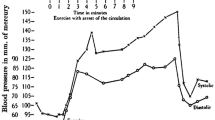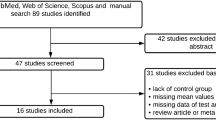Summary
Freeze-dried fibre-bundles (GF) of the anterior byssus retractor muscle (ABRM) ofMytilus develop in Ca2+-containing ATP-salt-solution almost the same isometric tension as the surviving muscle and maintain the same tension remnant when Ca2+ is deprived. The ratio ATPase/tension of Ca2+-activated GF (0.15 mcal/sec × kg tension × cm fibre at 20°C, determined from ATPase measurements) corresponds to the heat of maintenance of living muscle in tetanus (0.07 mcal/see × kg × cm), while it is nearly zero when GF are in the “catch” state in Ca2+-free solution.
Contrary to isometric tension and tension remnant, the energy expenditure and speed of tension development depend on temperature (Q 10≈3); moreover the ratio ATPase/tension of Ca2+-activated GF decreases to 70% as the extent of the “caught” state increases in the course of three successive periods of contraction. But it increases again to the former level when the catch is abolished.
These findings are discussed in relation to the “Paramyosin-theory” of catch. With regard to the typical ultrastructure of caught muscle fibres it is suggested that their increased economy is based on interaction of the thick paramyosinfilaments.
Similar content being viewed by others
Literatur
Baguet, F., Gillis, J. M.: The respiration of the anterior byssus retractor muscle ofMytilus edulis (ABRM) after a phasic contraction. J. Physiol. (Lond.)188, 67–82 (1967).
——: Energy cost of tonic contraction in a lamellibranch catch muscle. J. Physiol. (Lond.)198, 127–143 (1968).
Bailey, K.: The proteins of adductor muscles. Pubbl. Staz. Zool Napoli39, 96–108 (1956).
Grützner, P.: Die glatten Muskeln. Ergebn. Physiol.3, 12–88 (1904).
hanson, J., Lowy, J.: Evidence for a sliding filament contractile mechanism in tonic smooth muscles of lamellibranch molluscs. Nature (Lond.)184, 286–287 (1959).
Heumann, H. G., Zebe, E.: Über die Funktionsweise glatter Muskelfasern. Elektronenmikroskopische Untersuchungen am Byssusretraktor (ABRM) vonMytilus edulis. Z. Zellforsch.85, 534–551 (1968).
Jewell, B. R.: The nature of the phasic and the tonic responses of the ABRM ofMytilus. J. Physiol. (Lond.)149, 154–177 (1959).
Johnson, W. H.: Tonic mechanisms in smooth muscle. Physiol. Rev.42, (Suppl. 5), 113–143 (1962).
— Kahn, J. S., Szent-Györgyi, A. G.: Paramyosin and contraction of “catch muscles”. Science130, 161 (1959).
— Twarog, B. M.: The basis for prolonged contraction in molluscan muscles. J. gen. Physiol.43, 941–960 (1960).
Leenders, H. J.: Catch, peak tension and ATPase activity in glycerinated oyster adductor. Comp. Biochem. Physiol.31, 187–196 (1969).
Lowy, J., Hanson, J.: Ultrastructure of invertebrate smooth muscle. Physiol. Rev.42 (Suppl. 5), 34–47 (1962).
— Millman, B. M.: The contractile mechanism of the anterior byssus retractor muscle (ABRM) ofMytilus edulis. Phil. Trans. B246, 105–148 (1963).
— Hanson, M. J.: Structure and function in smooth tonic muscles of lamellibranch molusces. Proc. roy. Soc. B160, 525–536 (1964).
Marsh, B. B.: The estimation of inorganic phosphate in the presence of adenosine triphosphate. Biochim. biophys. Acta (Amst.)32, 357–361 (1959).
Millman, B. M.: Contraction of the opaque part of the adductor muscle of the oyster. J. Physiol. (Lond.)173, 238–262 (1964).
Minihan-Nauss, K., Davies, R. E.: Changes in inorganic phosphate and arginine during the development, maintenance and loss of tension in the anterior byssus retractor muscle ofMytilus edulis. Biochem. Z.345, 173–187 (1966).
Portzehl, H., Caldwell, P. C., Rüegg, J. C.: The dependence of contraction and relaxation of muscle fibres from the crabMaia squinado on the internal concentration of free calcium ions. Biochim. biophys. Acta (Amst.)79, 581–591 (1964).
Reedy, M. K., Holmes, K. C., Tregear, R. T.: Induced changes in orientation of the crossbridges of glycerinated insect flight muscles. Nature (Lond.)207, 1276–1280 (1965).
Rome, E.: X-ray diffraction studies of the filament lattice of striated muscle in various bathing media. J. molec. Biol.37, 331–344 (1968).
Rüegg, J. C.: On the tropomyosin-paramyosin system in relation to the viscous tone of lamellibranch “catch”-muscle. Proc. roy. Soc. B154, 224–249 (1961).
—: Tropomyosin-Paramyosin system and “prolonged contraction” in a molluscan smooth muscle. Proc. roy. Soc. B160, 536–542 (1964).
—: A biochemical approach to the catch problem. In: Biochemistry of muscle contraction, p. 412. Ed. J. Gergely. Boston: Little Brown & Co. 1964.
—: Physiologie und Biochemie des Sperrtonus. Helv. physiol. pharmacol. Acta, Suppl.16, 1–76 (1965).
—: Contractile mechanisms of smooth muscle. In: Aspects of cell motility, pp. 45–66. Ed. P. L. Miller. Cambridge: University Press 1968.
Rüegg, J. C.: Smooth muscle tone. Physiol. Rev.51, 201–248 (1971).
—, Straub, R. W., Twarog, B. M.: Inhibition of contraction in a molluscan smooth muscle by thiourea, an inhibitor of the actomyosin contractile mechanism. Proc. roy. Soc. B158, 156–176 (1963).
— Weber, H. H.: Kontraktionszyklus und Sperrtonus. In: Perspectives in biology, pp. 301–320. Ed. by C. F. Cori, V. G. Foglia, L. F. Leloir, and S. Ochea. Amsterdam: Elsevier 1963.
Schädler, M.: Proportionale Aktivierung von ATPase-Aktivität und Kontraktionsspannung durch Calciumionen in isolierten contractilen Strukturen verschiedener Muskelarten. Pflügers Arch. ges. Physiol.296, 70–90 (1967).
Schumacher, T.: Paramyosinstruktur und Sperrtonus. Experientia (Basel)26, 631–633 (1970).
Szent-Györgyi, A. G., Cohen, C., Kendrick-Jones, J.: Paramyosin and the filaments of molluscan “catch”-muscles. J. molec. Biol.56, 230–258 (1971).
Twarog, B. M.: Innervation and activity of a molluscan smooth muscle. J. Physiol. (Lond.)152, 220–235 (1960).
—: Factors influencing contraction and catch inMytilus smooth muscle. J. Physiol. (Lond.)192, 847–856 (1967).
Uexküll, J. v.: Studien über den Tonus. VI. Die Pilgermuschel. Z. Biol.58, 305–322 (1912).
Author information
Authors and Affiliations
Rights and permissions
About this article
Cite this article
Schumacher, T. Zum Mechanismus der ökonomischen Halteleistung eines glatten Muskels (Byssus retractor anterior,Mytilus edulis). Pflugers Arch. 331, 77–89 (1972). https://doi.org/10.1007/BF00587193
Received:
Issue Date:
DOI: https://doi.org/10.1007/BF00587193




